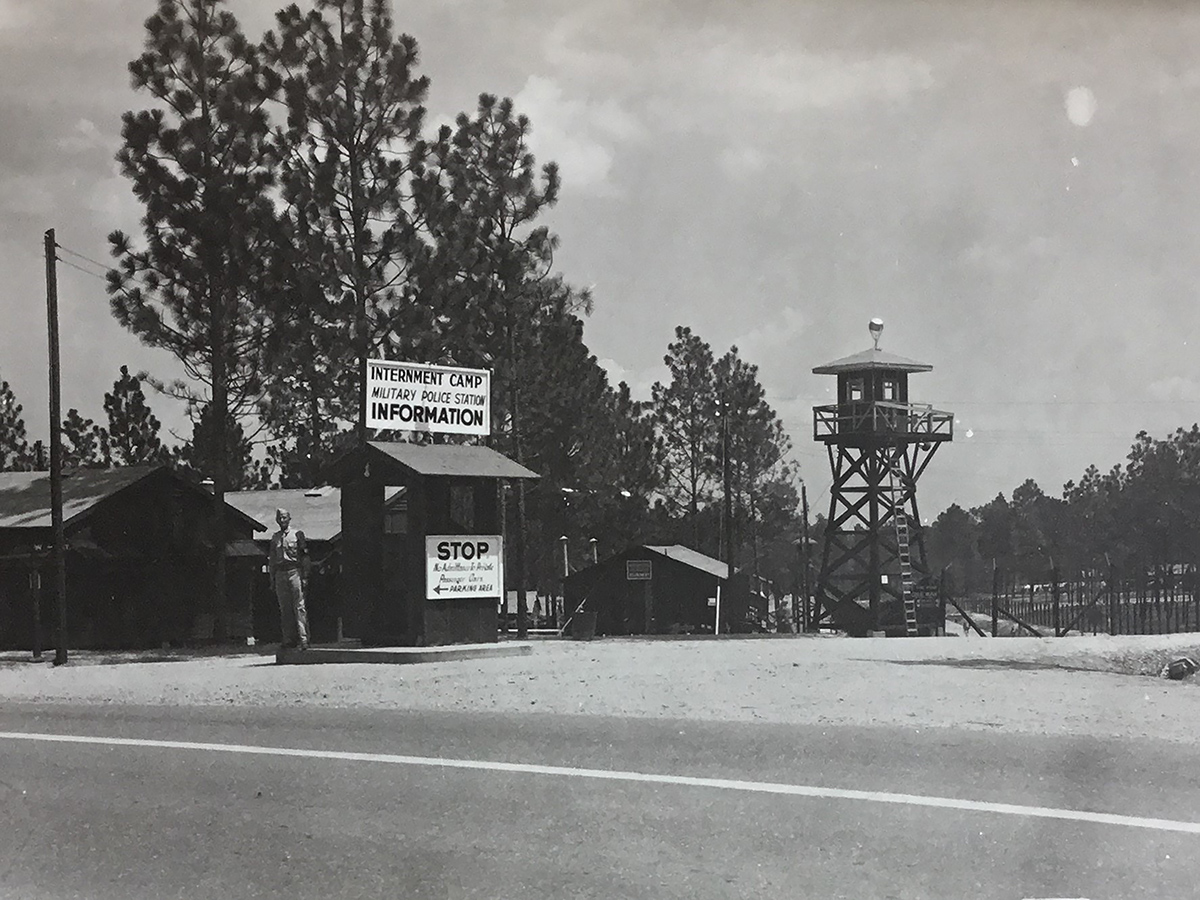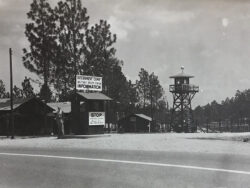Japanese Internment in Louisiana
The US government forcibly interned around twelve hundred Japanese American citizens and Japanese residents at Camp Livingston during World War II.

National Archives
Entrance to Camp Livingston, circa 1942–1943.
During World War II Louisiana was the site of Camp Livingston, a US Army facility located twelve miles outside the city of Alexandria that held Japanese civilian men as internees from 1942 to 1943. Most associated with the Louisiana Maneuvers, the camp’s history as an internment site of approximately twelve hundred Japanese civilian enemy alien men is not well known.
Japanese Internment in the United States
On February 19, 1942, President Franklin D. Roosevelt signed Executive Order 9066, which directed the forced removal of US citizens of Japanese descent and their immigrant parents from their homes on the West Coast into ten War Relocation Authority camps throughout the interior United States for the duration of the war. This forced removal of approximately 120,000 individuals is often covered in history texts but does not represent the full picture of what happened to people of Japanese descent in the United States during World War II. Less well known is the legally permissible—though morally questionable—internment of Japanese resident aliens who were detained and interned by the Department of Justice and the US Army beginning on December 7, 1941.
Prior to World War II many individuals born in Japan had immigrated to the United States. They were barred by federal law from becoming naturalized American citizens, even though the majority had lived in the United States for several decades, raised their children (who were US citizens) there, and had no plans to return to Japan. The term historically used for this immigrant population is “alien.” When the United States declared war on Japan, all Japanese resident aliens residing in the United States became “enemy” aliens in the eyes of the US government. The enemy alien internment program is a separate but parallel wartime detention program whereby non-US citizens could be legally detained and held because of their nationality.
Although internment affected the Japanese American community broadly, including women and children, some men were sent to all-male camps like Camp Livingston. Most men rounded up as enemy aliens in the hours after Pearl Harbor and beyond were immigrant community leaders who held positions of power or influence such as teachers, newspaper editors, and religious leaders. The men detained were sent to enemy alien internment camps and were separated from their families for years.
Camp Livingston Internment Camp
Camp Livingston was constructed in 1940 as an army base in preparation for the Louisiana Maneuvers, which were a training exercise to prepare the US Army for war. In February 1942, just days after President Roosevelt signed Executive Order 9066, the War Department ordered the construction of an alien internment camp to be built on the southwestern side of Camp Livingston. Construction of the internment camp was completed within two months and was built to hold five thousand internees as well as the military police that would stand guard over them.
Numbers vary, but at its peak, the internment camp held almost twelve hundred male internees of Japanese ancestry. The camp was situated on a hill and was made up of four sections. Barracks were newly built small structures that housed fifteen people each. Each section would hold Japanese men from different parts of the world—from Hawai’i, the mainland United States, and Latin America. The first group of seven hundred Japanese civilian men to be interned at Camp Livingston arrived by train on May 30, 1942. More men would soon follow.
Internee Life in Camp Livingston
Life for the internees was isolating and monotonous. Letters, diaries, memoirs, and interviews help to illuminate what daily life was like for the men within Camp Livingston. Intense heat, humidity, and a constant battle against mosquitos and other insects plagued the men. Most of the men interned at Camp Livingston were leaders within their communities. They formed their own governable units, held prayer services, broadcasted news, and participated in performances for entertainment. The men organized their own “internee university” with classes in English, carving, music, Spanish, and farming. The men channeled their feelings such as anger, loneliness, and hope into creating diverse types of art. Museum-style exhibitions were held within the camp to display their creations.
Labor was a requirement within the camp and was a harsh reality, as many of the internees were advanced in age and never had to do manual labor because of their professional vocations. Some men viewed the labor as a welcome respite from the monotony of camp life, while others resented the forced work. Labor disputes were a common occurrence in the camp, and the men were not afraid to exercise their rights under the Geneva Convention of 1929, which stipulated the types of work that were expected of them.
The Geneva Convention of 1929 also afforded protections and accommodations that extended to the men’s physical and intellectual activities within the camp. Accordingly the Army encouraged activities that promoted the health and mental well-being of the interned men. The internees engaged in many physical activities, but baseball was one of the most popular. The camp built two baseball fields to accommodate gameplay.
The men were able to communicate with their families through letter writing, though these letters were sent to official censor offices first. These censors would physically cut out pieces of the letters to ensure that no classified information was unintentionally shared. Official representatives from agencies like the International Red Cross visited the men in the camp to ensure their welfare. Eventually some men’s families were able to visit the men in the camp, including sons who were serving in the famed 442nd Infantry Regiment and were training at Camp Shelby in Mississippi.
Prisoner-of-War (POW) Camp and Later Closure
By June 1943 all the men held in the internment camp within Camp Livingston as Japanese enemy aliens were transferred to various other internment or incarceration camps around the country. None were released from the camp system until the conclusion of World War II. The internment camp at Camp Livingston was converted into a POW camp that would hold mostly German and Italian POWs. Camp Livingston was rendered inactive as an army base in November 1945. Today only a few physical remnants of Camp Livingston exist.
The internment and incarceration of those of Japanese ancestry was an egregious error committed by the US government. To quote the US National Park Service, “no person of Japanese ancestry living in the United States was ever convicted of any serious act of espionage or sabotage during the war.” To this end, the Civil Liberties Act of 1988 was signed into law by President Ronald Reagan and offered both an acknowledgment and formal apology to the Japanese American community for the incarceration and internment programs during World War II. The act recognized that the internment and incarceration were, in the words of Public Law 100-383, Wartime Relocation of Civilians, “motivated largely by racial prejudice, wartime hysteria, and a failure of political leadership.”
